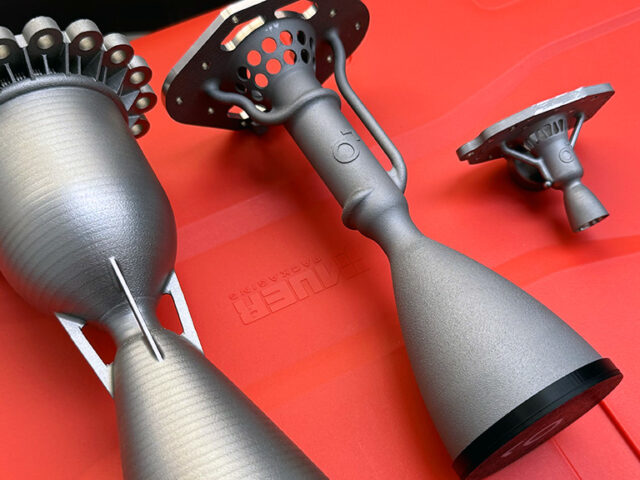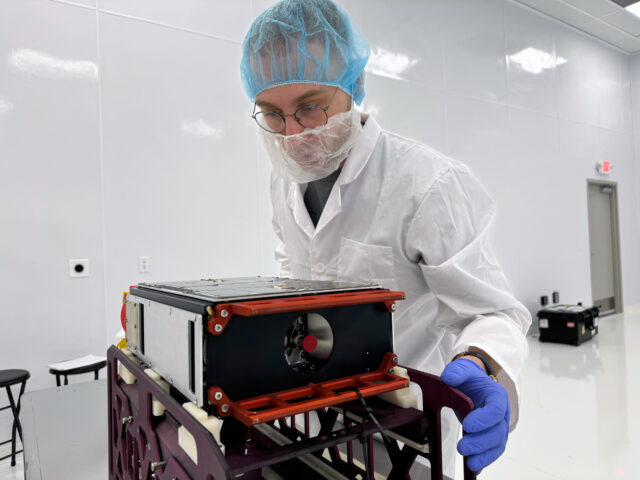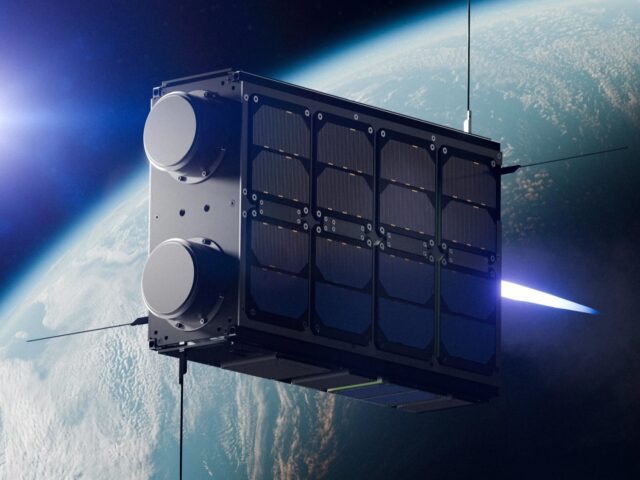Introduction
Hydrazine-based propulsion systems were the state-of-the-art solution for decades.
However, recent changes in the space market have led to a shift in the space propulsion landscape. The maturation of advanced electric propulsion has led to an all-electric trend, in which satellites do not use chemical propulsion systems at all. The rise of small satellites has driven an even higher uptake of miniaturized electric propulsion, which currently holds a significant part of the market.
At the same time, chemical propulsion remains critical in many space missions, as it offers one key advantage that electric propulsion can’t: high thrust.
That is why launchers don’t use electric propulsion, despite it being much more efficient. The situation in space looks different, but still, the large impulse bit and short maneuver time are important from the perspective of both achieving mission objectives (e.g., deep-space orbit insertion) and financial outcomes (downtime due to long maneuvers with electric propulsion).
The last two decades have seen increased interest in so-called green chemical propulsion, which is a less toxic alternative to hydrazine, leading to easier handling, reduced hazards, and significant cost savings.
Although the global search for next-generation green propellants to replace hydrazine has been ongoing for over two decades, there is still no clear winner. Alternatives with high Technology Readiness Levels (TRL) include LMP-103S, AF-M315E, or hydrogen peroxide (HTP), but all these options have some drawbacks that hamper broader market uptake. This is especially true for small satellites, which are a dominant part of the spacecraft launched into space.
Nitrous oxide-based bipropellants were introduced in recent years and quickly gained significant traction, achieving commercial success.
Although not an ideal propellant, Nitrous Oxide offers enough advantages to be the leading candidate for the hydrazine replacement. Soon, we may see such propulsion as a market standard, at least in the segment of small satellites.
In this article, we take a look at what makes Nitrous Oxide a promising propellant and analyse its pros and cons.
What choice do we have?
Before looking at nitrous oxide itself, it’s important to consider the options available.
The traditional toxic propellant, hydrazine, can be used as a monopropellant or as a fuel in combination with an oxidiser – Nitrogen Tetroxide (NTO) or other mixed oxides of nitrogen (MON), which are also highly toxic. Industry is interested in both green monopropellants and bipropellants, the latter being of greater importance.
While many substances can be used as fuels, the choice of oxidants is virtually limited to liquid oxygen, gaseous oxygen and hydrogen peroxide.
Liquid oxygen is cryogenic and cannot be stored in space, making its use impractical for smaller spacecraft. Gaseous oxygen must be stored at very high pressure, but still has a very low density, requiring large and heavy tanks.
Hydrogen peroxide, when used at concentrations above 90% (HTP), is a powerful oxidiser with high density and performance, but is plagued by storage and compatibility issues.
It is unstable during storage and gradually decomposes, resulting in loss of propellant and the need to vent excess pressure, even when chemically stabilised. In addition, HTP can decompose rapidly on contact with contaminants or organic material, releasing hot gas which presents a handling hazard. With negligible vapour pressure at room temperature, even a small leak can pose a risk to satellites and crew due to the corrosive nature of the propellant.
As we can see, each of the available oxidisers has serious drawbacks that prevent their widespread use in industry.
Advantages of Nitrous-based propulsion
Among the available choices, nitrous oxide appears to be the least problematic and offers unique advantages. Let’s take a look at what advantages nitrous oxide can offer.
Storability
Nitrous oxide is non-cryogenic and chemically stable, meaning it does not decompose or boil at room temperature. It also remains stable and does not freeze at very low temperatures, even below -50 degrees Celsius.
It can be stored virtually indefinitely in the space environment without degrading.
Safety
Nitrous oxide is non-toxic, especially when compared to hydrazine.
While it’s not entirely harmless to humans, it’s only harmful if ingested in large quantities over a long period of time. This is a significant improvement over hydrazine. Nitrous oxide is widely used in many industries and well-established safety regulations for compressed gases are readily applicable. Although as an energetic oxidiser its vapour phase has the potential for exothermic decomposition, this risk can be easily mitigated with basic safety standards. When satellites are fueled with propellants, this enhanced safety allows for simpler shipping, handling and refuelling procedures, which benefits pre-launch operations.
This is of particular benefit for rideshare missions, where a large number of small satellites have to be prepared for launch on a tight schedule.
Cold-Start
Propellants typically rely on hypergolic or catalytic decomposition to initiate combustion.
Hypergolic propellants are often unstable or toxic; for instance, several hypergolic fuel compositions developed for HTP contain metal salts or hydrides that can precipitate over time, causing the fuel to lose its properties. Catalytic beds, on the other hand, require preheating prior to ignition, which consumes time and electrical power. They also limit the total impulse that can be generated by a single thruster as they degrade over time.
Nitrous oxide-based propulsion systems typically use an electric arc for ignition. This approach can result in a longer response time, but allows cold starts and unlimited restarts without the need for pre-heating.
This increases the flexibility and responsiveness of the propulsion system.
System Simplicity
The most distinctive feature of nitrous oxide compared to other oxidisers is its high vapour pressure at room temperature.
This means that in a closed container holding liquid nitrous oxide, a portion will evaporate to raise the pressure of the container to a certain level. Whenever the container is opened to release liquid or gas, it will continue to maintain this pressure through vaporisation.
This phenomenon, known as self-pressurisation, can significantly reduce the complexity of the propulsion system. Unlike other oxidisers, nitrous oxide does not require an additional pressurising gas and can be combined with fuels that have similar self-pressurising properties, completely eliminating the need for external pressurisation – a feature not found in other solutions.
This simplicity of the system leads to improved reliability and a reduction in dry mass, both of which are critical factors for space missions.
Material Compatibility
Due to its lack of hypergolic properties and relatively stable nature compared to, for example, HTP, nitrous oxide is compatible with a wide range of typical aerospace materials such as titanium, stainless steel and aluminium alloys. Although some materials, such as copper, can have a slight catalytic effect, they are not commonly used in propulsion systems.
This broad material compatibility enables the use of off-the-shelf components already developed, facilitates their integration into existing designs and reduces the need for specialised components.
This is a critical feature in lowering the barrier to widespread market adoption of the new fuel.
Availability and Cost
Nitrous oxide, a well-known and readily available industrial gas, is used in a wide range of industries including medical, food, automotive and chemical.
Its cost as a propellant is negligible.
As a simple three-atom molecule, it is not tied to a secret formula. This ease of access and low cost is a significant advantage over specialised or proprietary propellants, which often limit market adoption due to their exclusivity and higher cost.
Disadvantages of Nitrous-based propulsion
Nitrous is far from an ideal propellant, and here is why.
Performance Limitations
Nitrous oxide is a relatively weak oxidiser, containing about 30% oxygen in each molecule, with the remainder being inert nitrogen that does not contribute to combustion.
For this reason, it is not physically feasible for nitrous oxide to match the peak specific impulse of high-end toxic propellants such as MMH/MON, which can achieve over 320 seconds. However, it is theoretically possible to achieve specific impulses of 290 or even 300 seconds with nitrous oxide.
Density
The relatively low density of liquid nitrous oxide, between 0.7-0.9 g/cm3, is nowhere near the toxic NTO or HTP, which are around 1.4 g/cm3.
But that can be compensated for by self-pressurisation. In fact, the packing density of nitrous oxide can be similar because other propellants require pressurant gas. For example, when HTP is used in blowdown mode, approximately half of the tank is filled with the helium, effectively reducing the HTP packing density to a similar level to that of N2O.
This has its limits, as in larger systems the external helium pressurisation would become more efficient, effectively resulting in a higher packing density.
Two-phase Flow
Self-pressurisation offers significant advantages, but also presents some challenges.
Nitrous oxide is in a saturated state when used with self-pressurisation, meaning that it will evaporate locally with any small change in pressure. This phenomenon introduces complex two-phase fluid behaviour into the tanks and feed system. While this is not an issue when using nitrous oxide as a gaseous oxidiser, extracting liquid from the tank introduces a complex two-phase flow that tends to be unstable and unpredictable.
This reliance on the gas phase limits the scalability of nitrous oxide-based propulsion systems to high thrust levels.
High pressure
At room temperature, nitrous oxide has a vapour pressure of about 52 bar, which is about twice the typical tank pressure in conventional chemical propulsion systems.
To contain such a high pressure, heavier tanks are required, increasing the dry mass of the system. This may not have a significant impact on smaller systems, but the problem quickly becomes significant for larger satellites.
However, the problem can be mitigated by using lightweight Composite Overwrapped Pressure Vessels (COPVs), which balance the need for strength with weight efficiency.
Conclusion
Nitrous Oxide is a mix of good and bad, but right now, it’s the best we’ve got for satellite propulsion.
We expect to see more and more satellites flying with nitrous based propulsion.
It’s shaping up to be the market standard, at least in the segment of small satellites.




